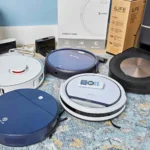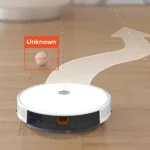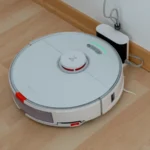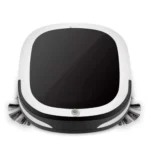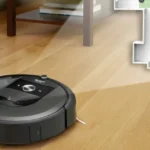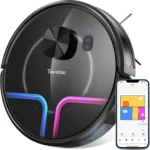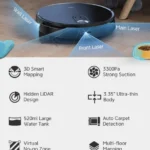Have you ever wondered how your smart vacuum cleaner moves around your house with such precision, avoiding obstacles and mapping the entire layout? The magic happens through a cutting-edge technology called “SLAM” – Simultaneous Localization and Mapping. However, even the most advanced technology can sometimes encounter issues. If your smart vacuum cleaner is acting up, don’t panic! This article will guide you through troubleshooting common SLAM-related issues, such as the vacuum cleaner getting stuck, cleaning the same spot multiple times, failing to map a room, and more. Let’s dive in and unravel the mysteries of SLAM.
What is SLAM and how does it work in smart vacuum cleaners?
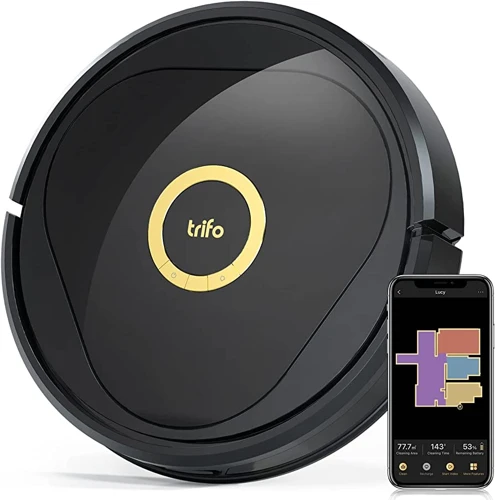
SLAM technology is at the forefront of modern robotic vacuum cleaners. It stands for Simultaneous Localization and Mapping, which allows a vacuum cleaner to navigate and map an area in real-time. This process makes it possible for the vacuum cleaner to clean a space efficiently while avoiding obstacles and adapting to changing environments. In this section, we will discuss the ins and outs of SLAM technology and how it is implemented in smart vacuum cleaners. If you want to learn more about SLAM in smart vacuum cleaners, check out our What is SLAM in Smart Vacuums? article.
1. Understanding SLAM technology
SLAM (Simultaneous Localization and Mapping) is a technology that has revolutionized the world of smart vacuum cleaners. It allows the vacuum cleaner to navigate and map an environment simultaneously while cleaning it.
How does SLAM work in smart vacuum cleaners?
SLAM technology uses various sensors including laser sensors, cameras, and wheels sensors to identify its position and orientation in an environment. The vacuum cleaner uses these sensors to build a map and simultaneously track its own location in the environment. The SLAM algorithm then intelligently creates a path for the vacuum cleaner to clean the entire area without getting lost.
What are the benefits of SLAM technology in smart vacuum cleaners?
There are several benefits of using SLAM technology in smart vacuum cleaners. It provides a more efficient and comprehensive cleaning experience than traditional vacuum cleaners. Vacuum cleaners equipped with SLAM technology can clean any shape of room, moving around the furniture with ease. It also saves time as it doesn’t require any manual intervention to create a map of the space.
How does SLAM technology differ from traditional mapping technology?
Unlike traditional mapping technology, SLAM constantly builds and updates its map in real-time. It overcomes obstacles in real-time, adapting to changeable environmental conditions. Traditional mapping technology also requires manual intervention to create a map before cleaning.
What are the potential future advancements for SLAM technology in smart vacuum cleaners?
As smart vacuum cleaners continue to evolve, SLAM technology will be integrated with other advanced technologies such as artificial intelligence and machine learning algorithms. They will also gain the ability to clean in the dark, overcoming the obstacle of low light conditions.
SLAM technology has been a game-changer for the smart vacuum cleaner industry, providing a seamless cleaning experience. To learn more about SLAM technology in smart vacuum cleaners, check out our in-depth article on the topic.
2. SLAM algorithms in vacuum cleaners
SLAM algorithms are crucial in making sure that a smart vacuum cleaner can effectively and efficiently navigate a room. The algorithms enable the device to map out an area and create a comprehensive layout of the room. In this way, it can identify obstacles and the areas that require cleaning.
The following are some of the SLAM algorithms commonly used in smart vacuum cleaners:
| Algorithm | Description |
|---|---|
| Extended Kalman filter (EKF) | This algorithm is used in combination with other sensors like lasers to improve the accuracy of the generated map. The EKF works by making use of the measurements of the sensors and the position and orientation of the vacuum cleaner to calculate its current position and map the surrounding environment. |
| Particle filter | This algorithm makes use of particles or virtual objects that act as the pose of the vacuum cleaner in the given environment. It works by predicting the pose through motion estimations, and then observing the measurements of the occupancy grid to correct the estimation. |
| Gmapping | This algorithm is a popular open-source SLAM algorithm for creating maps in robotics. It integrates sensor measurements to create maps with the use of the occupancy grid method. It is widely used in combination with LiDAR sensors. |
Each algorithm has its unique features and benefits, which ultimately aid the smart vacuum cleaner in identifying obstacles, creating accurate maps, and navigating effectively.
It is worth noting that smart vacuum cleaners that incorporate SLAM algorithms have significant advantages over traditional robotic vacuums. SLAM technology enables the devices to create accurate maps, which ensure that they clean every part of the room. You can learn more about the benefits of SLAM technology in smart vacuums by visiting this article.
As technology develops, it is expected that more advanced SLAM algorithms will be integrated into smart vacuum cleaners. This will enhance the efficacy of the devices, enabling them to clean even in pitch-dark environments. Check out this article to learn more about what the future holds for smart vacuum cleaners with SLAM technology.
3. SLAM-related terminologies
SLAM technology, or simultaneous localization and mapping, has revolutionized the way smart vacuum cleaners work in recent years. In addition to understanding how SLAM works and the various algorithms used in vacuum cleaners, it’s important to understand some of the terminologies associated with this technology. Here are some SLAM-related terminologies that are worth knowing:
- Localization: This refers to the process of determining where the robot vacuum cleaner is located in a given space. In the case of SLAM, this is done by analyzing data from various sensors and cameras on the device.
- Mapping: This refers to the process of creating a virtual map of the room or area being cleaned. This map can help the robot vacuum cleaner navigate more efficiently and avoid obstacles.
- Loop closing: This is a process that helps the robot vacuum cleaner correct errors in its positioning as it moves through a space. This is done by comparing new sensor data with previously collected data to ensure that the cleaner hasn’t deviated too far from its original path.
- Sensor fusion: This refers to the process of combining data from multiple sensors, such as lidar, cameras, and ultrasonic sensors, to get a better understanding of the environment. This helps the robot vacuum cleaner make better decisions about where to go and what obstacles to avoid.
- Back-end optimization: This is a process that takes the data collected from the robot vacuum cleaner’s sensors and refines the map to improve its accuracy. This optimization is done after the robot has completed cleaning the space and is back at its docking station.
- Front-end processing: This refers to the real-time data processing that the robot vacuum cleaner uses to navigate and clean a space. This processing is done on-the-fly as the robot moves through the room.
Understanding these terminologies can help you better understand how SLAM works in smart vacuum cleaners and can also help you troubleshoot issues that may arise. If you want to learn more about SLAM and how it compares to traditional mapping for smart vacuum cleaners or how SLAM affects cleaning in dark spaces, check out our other articles.
Common SLAM-Related Issues in Smart Vacuum Cleaners
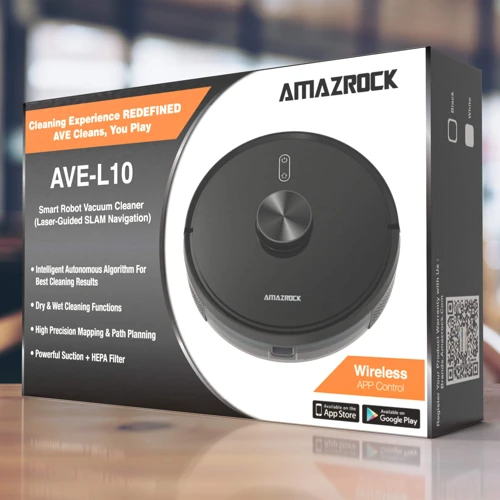
As smart vacuum cleaners become more popular, their capabilities have grown significantly thanks to simultaneous localization and mapping (SLAM) technology. However, even with the benefits provided by SLAM, you may encounter some common issues with your smart vacuum cleaner. These issues can prevent the vacuum cleaner from functioning optimally and could impact its ability to clean your home. In this section, we will discuss several of the most common SLAM-related problems that can occur with smart vacuum cleaners and provide tips on how to troubleshoot them effectively. Understanding these issues can help you better appreciate the capabilities of your smart vacuum cleaner and make the most of its features.
1. Vacuum cleaner gets stuck or moves in the same area repeatedly
When a smart vacuum cleaner keeps getting stuck or moving around in the same area repeatedly, it can be frustrating and time-consuming. This issue can be caused by various factors, including poor positioning or calibration of sensors, platform instability, poor mapping, and hardware or software malfunctions. Here are a few troubleshooting tips that can help resolve this issue:
1. Check the surroundings: Ensure the area where the vacuum cleaner is working is clear of physical obstructions such as small objects, rugs or cables that the vacuum cleaner may get stuck on. Avoid placing objects on the floor where the vacuum cleaner will be working as they can interfere with the robot’s path.
2. Adjust the sensors: Smart vacuum cleaners use various sensors to navigate around the home, such as LIDAR, ultrasonic and infrared sensors. If any of these sensors are not calibrated or if there is a problem with the sensor, the vacuum cleaner may have trouble navigating. Clean the sensors and ensure that they are not obstructed.
3. Update the firmware and software: Ensure that the vacuum cleaner’s firmware and software are up to date as outdated versions can cause mapping and navigation issues. Check the manufacturer’s website for updates or use the manufacturer’s app to verify the software version and update if needed.
4. Perform a reset and remap: If the vacuum cleaner continues to get stuck in the same spot or operates in the same area repeatedly, it may be necessary to perform a hard reset and create a new map. This can be done by resetting the robot to its factory settings or erasing the existing mapping and starting the mapping process again.
5. Contact the manufacturer: If none of the above steps resolve the issue, it may be a hardware malfunction that requires repair or replacement. Get in touch with the vacuum cleaner’s manufacturer for technical support or repair options.
Troubleshooting such SLAM-related issues requires a basic understanding of how smart vacuum cleaners range their surroundings and navigate using SLAM technology. To learn more about SLAM versus traditional mapping or challenges in dark environments, check out our articles on SLAM vs Traditional mapping for smart vacuum cleaners and Smart Vacuum Cleaners SLAM Obstacles Dark.
2. Vacuum cleaner misses spots or cleans the same spot multiple times
One of the most common SLAM-related issues that smart vacuum cleaners encounter is when they miss certain spots or clean the same spot multiple times. This can be frustrating for users who expect their vacuum cleaners to provide thorough cleaning with minimal supervision. If you’re having this issue, don’t worry – there are a few reasons why this may be happening and some troubleshooting tips to resolve it.
Possible reasons why your vacuum cleaner misses spots or cleans the same spot multiple times:
- Blocked sensors or cameras – the sensors and cameras on your vacuum cleaner are designed to detect obstacles and map out your room. If they are blocked or not functioning properly, your vacuum cleaner may miss certain spots or repeat cleaning.
- Low battery – if your vacuum cleaner’s battery is running low, it may not be able to complete its cleaning cycle, resulting in missed spots.
- Dirty or worn-out brushes – if your vacuum cleaner’s brushes are dirty or worn out, it may not be able to pick up dirt and debris effectively, resulting in missed spots.
- Incorrect mapping – if your vacuum cleaner’s mapping algorithm is not accurate, it may miss certain spots or clean the same spot multiple times.
Troubleshooting tips to resolve the issue:
- Restart the vacuum cleaner and clean the sensors and camera – try restarting your vacuum cleaner and cleaning the sensors and camera. Dust and debris can accumulate on these components, causing them to malfunction. Use a clean, dry cloth to wipe them down, and try running your vacuum cleaner again.
- Charge the battery – if your vacuum cleaner is running low on battery, make sure to charge it fully before using it again. This will give it enough power to complete its cleaning cycle and avoid missed spots.
- Replace the brushes – if your vacuum cleaner’s brushes are dirty or worn out, consider replacing them. Dirty brushes can’t pick up dirt and debris effectively, while worn-out brushes can’t make good contact with the floor, resulting in missed spots.
- Reset the map and create a new one – if your vacuum cleaner’s mapping algorithm is not accurate, try resetting the map and creating a new one. This will help your vacuum cleaner to accurately detect obstacles and edges, reducing the likelihood of missed spots.
- Contact the manufacturer for technical support – if none of the above troubleshooting tips work, it may be time to contact the manufacturer for technical support. They can provide more advanced troubleshooting tips or repair or replace your vacuum cleaner if necessary.
By following these troubleshooting tips, you can resolve the issue of your smart vacuum cleaner missing spots or cleaning the same spot multiple times. Remember to keep your vacuum cleaner clean and up-to-date with the latest firmware and software updates to ensure optimum performance.
3. Vacuum cleaner fails to map a room or map is incorrect
One of the common issues that users face when dealing with smart vacuum cleaners is that the map of the room(s) that the vacuum cleaner creates may be incorrect or the map might fail to form at all. This can lead to inefficient cleaning, as the vacuum cleaner may repeatedly clean the same spots or miss certain areas entirely.
Causes of Mapping Issues
There can be various reasons for a vacuum cleaner to fail to map a room or create an inaccurate map. These include:
| Issue | Cause |
| Dirty sensors | The sensors on the vacuum cleaner may be dirty or blocked by debris, dust, or pet hair. As a result, the vacuum cleaner may fail to accurately detect objects and obstacles, causing errors in mapping. |
| Low battery | If the battery of the vacuum cleaner is running low, it may fail to complete its mapping correctly. This may be due to the vacuum cleaner’s inability to maintain consistent movement and alignment. |
| Obstacles | If there are obstacles such as furniture, toys, or other items in the path of the vacuum cleaner, it may not be able to scan the area correctly, leading to an incorrect map. |
| Outdated software or firmware | The vacuum cleaner’s software or firmware may be outdated, causing mapping errors. This can be due to bugs or glitches that prevent the vacuum cleaner from functioning properly. |
| Uneven surfaces | If the surface of the floor is uneven or has gaps, the vacuum cleaner may not be able to map the area accurately. |
Troubleshooting Tips
If you are experiencing mapping issues with your vacuum cleaner, there are a few troubleshooting tips that you can try to resolve the problem. These include:
| Troubleshooting Tip | Description |
| Clean the sensors and camera | Check the sensors and camera of the vacuum cleaner to ensure they are clean and free of any debris or pet hair. This can help improve the accuracy of the mapping. |
| Check for obstacles | Remove any obstacles that may be blocking the path of the vacuum cleaner, such as furniture or toys. |
| Update the firmware and software | Check for any available updates on the vacuum cleaner’s software or firmware and install them. This can help fix any bugs or glitches that may be responsible for the mapping issues. |
| Reset the map | Reset the mapping feature of the vacuum cleaner and create a new map from scratch. Make sure the floor is free of any clutter and obstacles prior to initiating the mapping. |
| Contact the manufacturer | If none of the above tips help, contact the manufacturer’s customer support for technical assistance. |
By following these troubleshooting tips, you can easily identify and resolve mapping issues with your smart vacuum cleaner, ensuring efficient and accurate cleaning results.
4. Vacuum cleaner spins in circles or moves erratically
One of the common issues that users face with smart vacuum cleaners is when the device spins in circles or moves erratically, which can be frustrating and defeat the purpose of the cleaning robot. This issue often occurs due to sensor or algorithm errors, which can be fixed with a few troubleshooting tips.
Table: Troubleshooting Spinning or Erratic Movements
| Steps | Description |
| — | — |
| 1. Perform a sensor check | Check the vacuum cleaner sensors to ensure they are clean and free from any debris or dust that may affect their accuracy. |
| 2. Restart the device | Sometimes the issue can be resolved by just restarting the vacuum cleaner, which can reset the sensors and allow the device to recalibrate. |
| 3. Check the wheels | The wheels might be damaged, clogged with dirt, or have hair wrapped around them, which may cause the vacuum cleaner to spin or move around erratically. Check and clean them as needed. |
| 4. Check and adjust the environment | Ensure that the environment in which the vacuum cleaner is operating is free from obstacles, furniture, or any other object that may block or hinder the device’s movement. Move any obstacles that might be in the way of the vacuum cleaner. |
| 5. Update the device firmware or software | Check if there are any available updates to the vacuum cleaner’s software or firmware, and if so, install them. These updates often improve the device’s performance and can resolve issues such as spinning or erratic movements. |
| 6. Reset the device | If all else fails, reset the vacuum cleaner to its factory settings, which will erase any mapped areas, schedules, or custom settings, and return the device to its default settings. |
By following these simple troubleshooting tips, users can resolve spinning or erratic movement issues with their smart vacuum cleaner and enjoy a cleaner home without any frustration. If the issue persists even after trying these tips, users can always contact the manufacturer’s technical support for further assistance.
5. Vacuum cleaner skips rooms or fails to clean multiple rooms
One of the most frustrating issues that users can experience with their smart vacuum cleaners is when they skip rooms or fail to clean multiple rooms. This can occur for several reasons, including sensor and mapping issues. Here are some possible reasons why your vacuum cleaner may be skipping rooms or failing to clean multiple rooms, and what you can do to troubleshoot the issue:
| Possible reasons for skipping rooms or failing to clean multiple rooms | Troubleshooting steps |
|---|---|
| 1. Poor mapping: If the vacuum cleaner has not properly mapped the room, it may skip certain areas or fail to clean multiple rooms altogether. | – Reset the map and have the vacuum create a new map. – Ensure that the room is well-lit, as darkness can affect the sensors. – Remove any large objects that may be blocking the vacuum cleaner’s path or sensors. – Make sure that the vacuum cleaner is placed in a central location so that it can adequately map the entire room. – If the problem persists, contact the manufacturer for technical support. |
| 2. Weak Wi-Fi signal: A weak Wi-Fi signal can affect the vacuum cleaner’s ability to communicate with the app and properly clean multiple rooms. | – Move the router closer to the vacuum cleaner to improve the signal strength. – Reset your router or modem to see if that improves connectivity. – Check with your internet service provider to ensure that you have sufficient bandwidth for your home and all its devices. |
| 3. Low battery: If the vacuum cleaner’s battery is low, it may skip rooms or fail to clean multiple rooms before shutting down. | – Charge the vacuum cleaner to full capacity before use. – Check to ensure that the charging dock is properly connected to a power source and that the vacuum cleaner is properly docked for charging. – Adjust the cleaning schedule to avoid the vacuum cleaner starting a new cleaning cycle when the battery is running low. |
| 4. Obstacles: If there are obstacles in the room, the vacuum cleaner may skip rooms or fail to clean multiple rooms. | – Remove any large objects or tangled wires that may pose a hazard to the vacuum cleaner’s movement. – Clear the edges of the room, as these areas can sometimes be missed by the sensors. – Reconfigure any furniture or debris that can block the vacuum cleaner from reaching certain areas. – Utilize virtual walls or no-go zones in the app to keep the vacuum cleaner from moving into restricted areas. |
By following these troubleshooting tips, you can improve your smart vacuum cleaner’s performance and ensure that it fully cleans all of the designated areas in your home. However, if the problem persists, it may be necessary to contact the manufacturer for further assistance.
Troubleshooting Tips for SLAM-Related Issues in Smart Vacuum Cleaners
Now that you have identified common SLAM-related issues in smart vacuum cleaners, it’s time to troubleshoot them. Let’s dive into some practical solutions for ensuring that your vacuum cleaner is performing at its best. From simple sensor cleaning to firmware updates, there are several steps you can take to improve the performance of your vacuum cleaner. In this section, we will provide step-by-step instructions for troubleshooting SLAM-related issues and help you get your vacuum cleaner back on track.
1. Restart the vacuum cleaner and clean the sensors and camera
When your smart vacuum cleaner faces SLAM-related issues, one of the first steps to troubleshoot these issues is to restart the vacuum cleaner and clean its sensors and camera. This step is vital because dirty sensors and camera can lead to inaccurate readings and hinder the vacuum cleaner’s ability to map the environment correctly.
To execute this step, you need to follow these simple instructions:
| Step 1: | Turn off the vacuum cleaner and unplug it from the charging dock. |
| Step 2: | Remove the dustbin and empty it. Be sure to clean any debris or dirt from the filter. |
| Step 3: | Clean the sensors and camera on the vacuum cleaner. Dust off, wipe with a clean cloth or use compressed air to clean the sensors and camera. Ensure that there is no dust, dirt, or hair on them, so they read the environment correctly. |
| Step 4: | Check the wheels for any obstructions or damage. If there is any dirt or debris stuck in the wheels, remove them carefully. |
| Step 5: | Once you have finished cleaning, put the dustbin back in place and plug the vacuum cleaner back into the charging dock. Turn it on and start the cleaning cycle again to see if the SLAM-related issues persist. |
By following these steps, you ensure that the vacuum cleaner has a clean and clear view of the room and is ready to perform its duties accurately. If the issue continues, try proceeding to the next steps to troubleshoot your smart vacuum cleaner further.
2. Check for obstacles that may prevent the vacuum cleaner from moving
When encountering SLAM-related issues with your smart vacuum cleaner, it’s important to check if there are any obstacles hindering its movement. Some common obstacles that could affect your vacuum cleaner’s ability to move around include furniture, rugs, cords, and other objects lying on the floor.
Here are some steps you can take to check for obstacles and ensure that your vacuum cleaner can move around freely:
- Thoroughly inspect the room: Take a walk around the room and inspect it from the vacuum’s point of view. Look for any objects on the floor that could obstruct the vacuum’s path, such as chairs, toys, or cords.
- Clear the path: Remove any objects that could prevent the vacuum cleaner from moving around freely. Pick up small objects and move light furniture out of the way. For larger furniture, make sure the vacuum cleaner can easily move around it.
- Secure cords and cables: Make sure all cords and cables are neatly tucked away and aren’t lying on the floor. Not only can they be a tripping hazard, but they can also get tangled up in the vacuum’s brushes.
- Keep doors open: If you’re trying to clean multiple rooms, make sure all the doors are open and the vacuum cleaner has a clear path to move from room to room.
By checking for obstacles that may prevent the vacuum cleaner from moving, you can help ensure that it is functioning properly and not getting stuck or spinning around in circles. Taking these steps can save you time and prevent frustration when it comes to cleaning your floors with a smart vacuum cleaner.
3. Update the firmware and software of the vacuum cleaner
When your smart vacuum cleaner exhibits SLAM-related issues, updating its firmware and software can be an effective troubleshooting solution. Here are the steps to update the firmware and software of your vacuum cleaner:
- Step 1: Check the model of your vacuum cleaner and go to the manufacturer’s website to look for the latest firmware and software updates. Make sure to download the correct version that matches your vacuum cleaner model.
- Step 2: Prepare a USB drive and format it to FAT32. Copy the firmware and software files into the USB drive’s root directory.
- Step 3: Turn off the vacuum cleaner and plug in the USB drive to its port.
- Step 4: Turn on the vacuum cleaner and wait for the update process to start. It may take a few minutes for the update to complete. Do not turn off the vacuum cleaner or unplug the USB drive during the update process.
- Step 5: Once the update is complete, the vacuum cleaner will automatically restart. Remove the USB drive from the port.
- Step 6: Test the vacuum cleaner to see if the SLAM-related issues have been resolved. If not, you may need to try other troubleshooting solutions or contact the manufacturer for further assistance.
Updating your vacuum cleaner’s firmware and software can improve its SLAM capabilities and address any bugs or glitches that may be causing SLAM-related issues. It is important to regularly check for updates and perform them as needed to ensure the optimal performance of your smart vacuum cleaner.
4. Reset the map and create a new one
One of the troubleshooting tips for SLAM-related issues in smart vacuum cleaners is to reset the map and create a new one. This can be done if the vacuum cleaner is unable to map a room or if the map is incorrect.
Resetting the map will erase all the old data and create a new map from scratch. To reset the map and create a new one, follow these steps:
- Turn off the vacuum cleaner.
- Find the reset button on the vacuum cleaner or in the app.
- Press and hold the reset button until the indicators start flashing or until you hear a sound.
- Release the button and wait for the vacuum cleaner to restart.
- Place the vacuum cleaner in the center of the room and start a new cleaning cycle.
During the cleaning cycle, the vacuum cleaner will scan the room and create a new map. If the SLAM-related issue was caused by a wrong map, this should fix the problem. However, if the vacuum cleaner is still experiencing issues, contact the manufacturer’s technical support for further assistance.
It is important to note that resetting the map will also erase any saved cleaning schedules and preferences. You will need to set them up again after resetting the map.
In addition to resetting the map, it is also advisable to update the firmware and software of the vacuum cleaner to ensure that it is running on the latest version. This may also fix SLAM-related issues and improve the overall performance of the vacuum cleaner.
5. Contact the manufacturer for technical support
Contacting the manufacturer for technical support should be a last resort, but if all troubleshooting methods fail, this might be your best option in resolving SLAM-related issues with your smart vacuum cleaner. Here are some steps to follow when contacting the manufacturer for technical support:
- Collect information: Before contacting the manufacturer, make sure you have all the necessary information about your vacuum cleaner. This includes the model number, serial number, and any error messages you may have encountered. This will ensure that the manufacturer can quickly identify the issue.
- Check the warranty: If your vacuum cleaner is still under warranty, check the terms and conditions before contacting the manufacturer. This will help you understand what kind of repairs or replacement the manufacturer can offer.
- Reach out to customer support: Most manufacturers have a dedicated customer support line or email address. Contact them and explain the issue you are facing with your smart vacuum cleaner. They may ask you to perform some additional troubleshooting steps or provide some more information.
- Follow the manufacturer’s advice: If you are asked to perform any additional troubleshooting steps, make sure you follow them carefully. This will ensure that the manufacturer can quickly diagnose the issue and provide a resolution.
- Consider repair or replacement options: If the issue cannot be resolved by troubleshooting or firmware updates, the manufacturer may offer repair or replacement options. Be sure to ask about any costs involved and compare them to the cost of a new vacuum cleaner before making a decision.
Remember, contacting the manufacturer should be a last resort. You should try all troubleshooting methods before reaching out to them for technical support. However, if all else fails, contacting the manufacturer can help you resolve the SLAM-related issues with your smart vacuum cleaner.
Conclusion
In conclusion, troubleshooting SLAM-related issues in smart vacuum cleaners can be a challenging task. However, by understanding the basics of SLAM technology, its algorithms and related terminologies, it becomes easier to identify and address any problems that may arise.
Common issues related to SLAM in smart vacuum cleaners include getting stuck or moving in the same area repeatedly, missing spots or cleaning the same spot multiple times, failing to map a room or having an incorrect map, spinning in circles or moving erratically, and skipping rooms or failing to clean multiple rooms.
To troubleshoot these issues, it’s important to restart the vacuum cleaner and clean its sensors and camera, check for obstacles that may obstruct the vacuum cleaner’s movement, update the firmware and software of the device, reset the map and create a new one, and as a last resort, contacting the manufacturer for technical support.
By maintaining the cleanliness and proper functioning of the sensors and camera of the smart vacuum cleaner, and keeping the device’s firmware and software up-to-date, it is possible to minimize the occurrence of SLAM-related issues.
In summary, by following the troubleshooting tips outlined in this article, smart vacuum cleaner users can stay on top of the problems while enjoying the convenience and efficiency of a device that leverages state-of-the-art SLAM technology to clean their homes.
Frequently Asked Questions
What is the advantage of using a smart vacuum cleaner with SLAM technology?
Smart vacuum cleaners with SLAM technology offer efficient cleaning of your home. They can navigate and map your home in real-time and avoid obstacles. They can also clean under furniture, which is difficult for traditional vacuum cleaners.
What can cause a smart vacuum cleaner to move in circles?
A smart vacuum cleaner’s movement in circles may be caused by dirty sensors, low battery, or navigation errors. You can troubleshoot this issue by restarting your vacuum cleaner, cleaning the sensors and camera, and updating the firmware and software.
Can a smart vacuum cleaner with SLAM technology clean multiple rooms?
Yes, smart vacuum cleaners with SLAM technology can clean multiple rooms. They use real-time mapping to navigate and clean each room separately while avoiding obstacles.
How can I reset my smart vacuum cleaner’s map?
You can reset your smart vacuum cleaner’s map by following the manufacturer’s instructions. Usually, you will have to press and hold the reset button for a certain period of time.
Is it normal for a smart vacuum cleaner to miss spots?
No, it is not normal for a smart vacuum cleaner to miss spots. It may be caused by the sensor’s blockage, low battery or ram errors. In order to troubleshoot this issue, you should restart your vacuum cleaner and clean the sensors and camera.
Does a smart vacuum cleaner with SLAM technology require Wi-Fi connectivity?
Some smart vacuum cleaners with SLAM technology require Wi-Fi connectivity to work with their app. However, some models can work without Wi-Fi and do not require any app to operate.
How can I update my smart vacuum cleaner’s firmware and software?
You can update your smart vacuum cleaner’s firmware and software by following the manufacturer’s instructions. Usually, you can update it automatically using the app or by downloading the update manually from the manufacturer’s website.
What is the lifespan of a smart vacuum cleaner with SLAM technology?
The lifespan of a smart vacuum cleaner with SLAM technology can vary depending on the model, maintenance, and usage. Generally, it can last for several years with proper care and maintenance.
What should I do if my smart vacuum cleaner gets stuck?
If your smart vacuum cleaner gets stuck, you should turn it off and remove the obstruction. You should also check for any obstacles that may prevent your vacuum cleaner from moving.
Can I use a smart vacuum cleaner with SLAM technology for commercial purposes?
Yes, you can use a smart vacuum cleaner with SLAM technology for commercial purposes. However, you should choose a model with a higher capacity and durability to withstand heavy usage.

